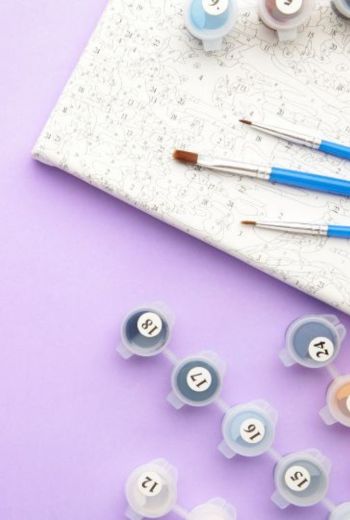The History of Painting by Numbers

The origin of painting by numbers and its introduction to the public
The very first patent for the concept of painting by numbers was filed in the United States in 1923. But it went unused.
A year later, in 1924, Dan Robbins was born in Cleveland, Ohio. In the 1950s, he began a career as a commercial artist for the Palmer Paint Company, a company that manufactured and sold washable paint posters for children.
Robbins' boss, Max Klein, set him a challenge. Klein wanted to break into the adult painting market. He commissioned Robbins to create a product that would be suitable for an adult audience – but would require no talent.
Robbins knew that Leonardo da Vinci sometimes drew lines and numbered areas on designs for apprentices to work on. Robbins imagined a kit including a pre-printed canvas, paints, and instructions to connect the colours with the numbered areas on the canvas – so that anyone could create a beautiful painting, with minimal effort. It was the first paint by numbers kit as we know them today!
Robbins himself painstakingly hand-processed all the frames that were used to print the first numbered canvases. The kits were marketed as a fun family activity, and they quickly became very popular, especially with women and children. Robbins is credited with revolutionising the world of art education, allowing people of all ages and skill levels to experience the joy of creating their own works of art.
Under the brand Craft Masters (which still exists today), the Palmer Painting Company quickly embarked on mass production, becoming the most famous company producing paintings by numbers.
Robbins continued to work in art-related fields, and was active in the world of art education throughout his career. He was a true visionary. He died in 2019 at the age of 93, but his impact on the world of arts education continues to be felt today.
The rise in popularity of painting by numbers in the mid-20th century
In the 1950s and 60s, painting by numbers saw a surge in popularity. They made it easy to create beautiful works of art without any training. Celebrities including Grace Kelly were known to enjoy this hobby, and contributed to its popularity.
A growing economy in the USA, as well as massive industrialisation, made it possible to considerably increase production. Very quickly, the Palmer Painting Company faced dozens of competitors, in the US and worldwide, and especially in Europe.
Advances in technology and their impact on the painting by numbers industry
With advances in technology, the production of paint by numbers has become more sophisticated and efficient.
In the 1990s, the introduction of digital printing and advanced colour matching techniques made it possible to create high-quality detailed kits with a wider range of colour options.
Today, paint by numbers kits are available in a wide variety of styles and themes, including custom options.
In recent years, painting by numbers has seen a resurgence in popularity, especially as a hobby activity during lockdown periods (2020-21). Companies have responded by investing in high-quality printing materials and technologies. The paints used in modern paint by numbers kits are now even better quality, with brighter colours and greater coverage, allowing hobbyists to achieve a near-professional result. The canvases are also better quality, made of durable materials that resist deformation and fading over time.
Modern printing methods mean companies can produce high-definition images with more detail and clarity. This makes it possible to reproduce some of the most complex works of art, staying precise and faithful to the originals. Many companies are now using digital printing technology to produce their kits, allowing them to print images with a high degree of colour accuracy.
6 anecdotes from the history of painting by numbers
- The first paint by numbers kits were marketed under the name "Paint by Number". The name later became synonymous with this activity in the English language.
- Paint by numbers kits were often seen as a way to create cheap reproductions of famous paintings, such as the works of Vincent van Gogh and Leonardo da Vinci.
- One of the most famous fans of number painting is former US President Dwight D Eisenhower, who took up this hobby while in office.
- Some contemporary artists, such as Salvador Dalí and Pablo Picasso, are known for using number painting as a way to explore new techniques and different styles.
- After the boom of the early years, the popularity of paint by numbers remained constant. Today it's estimated that there are more than 100 million paint by numbers kits in circulation worldwide.
- Number painting is used in therapies for disabled or injured people, including people with Alzheimer's, dementia and Parkinson's disease. The repetitive movements and concentration required for this activity have been shown to improve hand-eye coordination and mental clarity.

